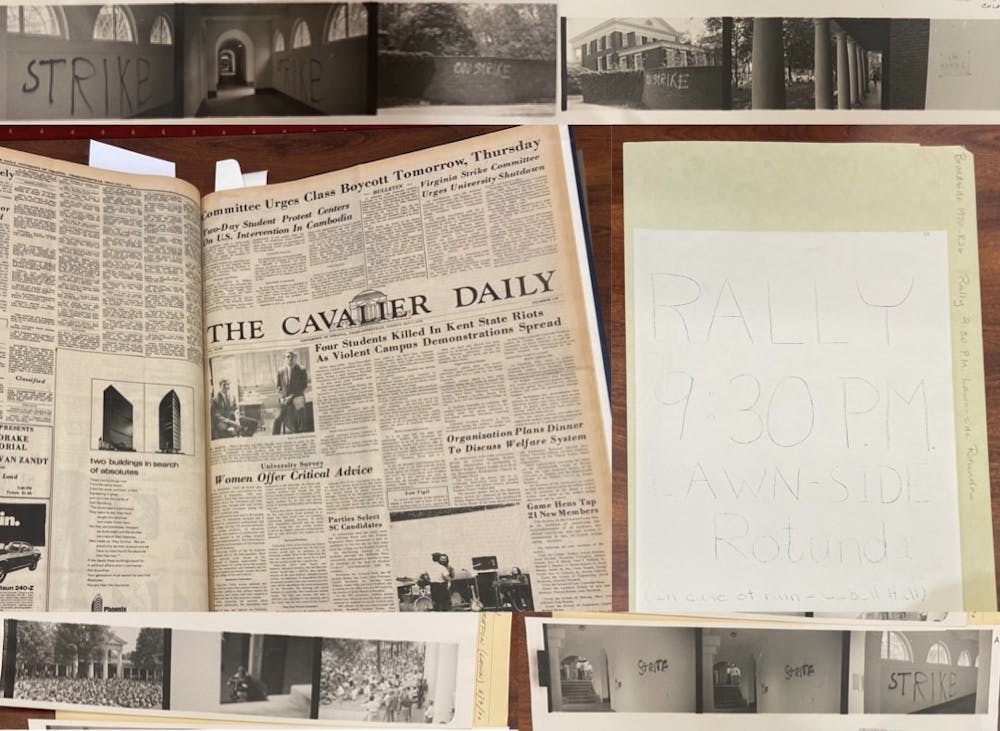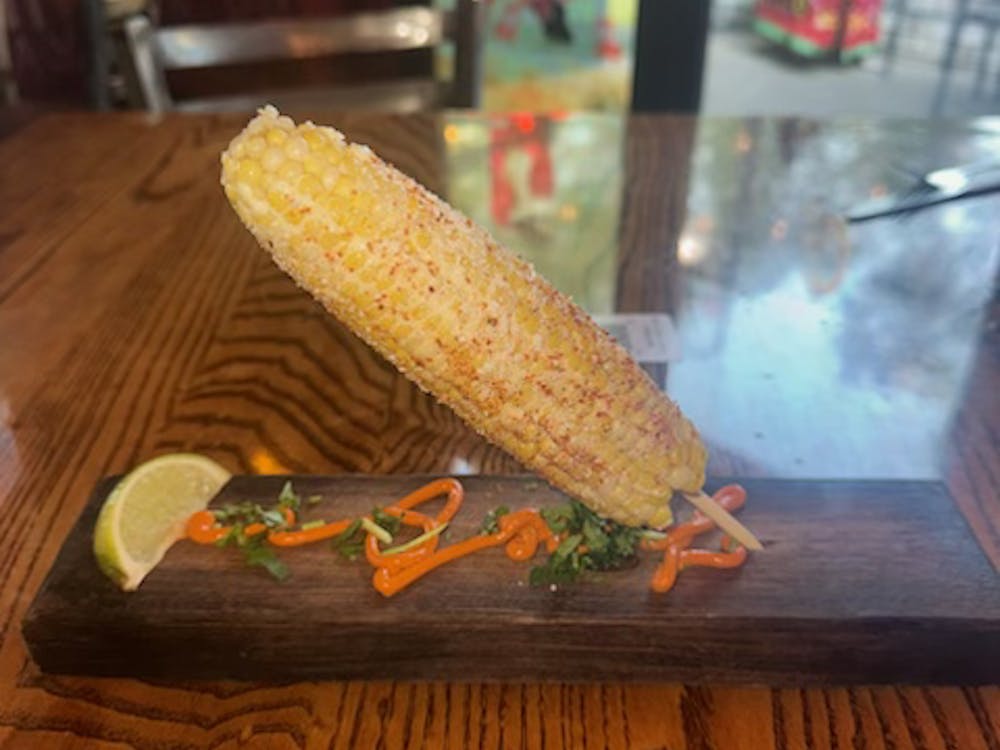History has a way of resonating into the present, providing astonishing parallels that help us make sense of our present moment and suggest ways to move forward. Such a notion echoed through the auditorium of the Special Collections Library Tuesday when students in MDST 3903, “Media and Protest: The 1960s” gathered to discuss the University’s May Days protests.
Occurring in May 1970, May Days was a series of protests, including a University-wide strike, that student activists organized in response to both the Kent State University massacre — in which four Kent State University students engaged in an anti-war protest were killed by national guardsmen — and the expansion of the Vietnam War into Cambodia.
“The murders at Kent State basically set off this firestorm across the country,” said Carly Lester, a fourth-year College student in MDST 3903. “May Days basically was widespread student protests across the University of Virginia and a list of demands to the president asking him to change things at the University because things weren't up to par with what they believed was a just, progressive environment.”
Tuesday’s class was held in the Special Collections Library, with physical news articles and photos from 1970 set on tables at the perimeter of the room. It began with opening remarks from class instructor Prof. Aniko Bodroghkozy, who then introduced a series of student presentations covering different Charlottesville-based news publications’ coverage of the May Days protests. Students presented on coverage by The Cavalier Daily and The Daily Progress, as well as The Virginia Weekly and The Sally Hemings — two underground, student-run newspapers.
Caroline Sloan, a second-year College student taking MDST 3903, explained that group presentations are a weekly occurrence for the class. Students are placed in groups at the beginning of the semester, and each week they present with the same groups on a series of primary source documents that correspond with what the class is covering that week. Students typically send one member of the group to the Special Collections Library ahead of time to examine and take pictures of the document, and the remaining members work to craft the presentation virtually.
“Each week has a different theme, and then each group ... [will] work dissecting different media coverage of the same event,” Sloan said. “My group today had an old edition of Cav Daily, which was really cool to look at because … I read The Cav Daily, and it was cool to see the difference between now and then.”
The first two groups to present examined The Cavalier Daily’s news coverage of May Days between May 3 and May 14, 1970. The groups analyzed the often conflicting language of the articles’ headlines — paying particular attention to their level of objectivity — and compared them with The New York Times’ coverage of the 1968 student protests at Columbia University. Headlines included objective reports on the student strike, as well as calls to end the protests and suggestions of how to move forward, as May Days took place during exam season. The groups concluded that The Cavalier Daily’s coverage was generally moderate, likely to appease the University’s moderate to right-leaning students.
The third group to present analyzed the coverage of Charlottesville’s The Daily Progress, which tended to lean moderate to right in 1970. Students noted how the paper tended to take a neutral stance on movements like Women’s Liberation and the Black Power movement and tended to embody a white, middle-class aesthetic.
The paper also included a political cartoon that criticized University students for going on strike and seemed to take a generally pro-war stance. Second-year College student Mimi Lamarre, one of the presenters of The Daily Progress, found it interesting to compare The Daily Progress coverage with the coverage written by students and people of the younger generation.
“The Daily Progress ... definitely showed more a conservative view from the older generation,” Lamarre said. “That comparison was super interesting to me, and I think it shows … student voices are important … even publications like The Cavalier Daily, which are University-affiliated.”
In a stark contrast to The Cavalier Daily and The Daily Progress, The Virginia Weekly — an underground publication run by University students — voiced strong left-leaning sentiments, as concluded by the fourth group. They explained that in 1970, the publication openly supported the May Days strike, as well as issues such as welfare and Women’s Liberation. The paper also heavily criticized the University, as well as the broader society in which it existed, frequently referring to Charlottesville cops as “pigs” and the United States as the Ku Klux Klan.
The final group examined The Sally Hemings — another underground student-run paper that reported specifically on the strike. The paper strongly supported the students’ demands, and often used satirical cartoons to highlight the University’s role in supporting the war effort and various systems of inequity in the United States. Bodroghkozy emphasized just how radical a newspaper title like The Sally Hemings would have been in 1970 — a time when almost no one discussed Thomas Jefferson’s racial and sexual tyranny over Sally Hemings, one of Jefferson’s slaves who bore six of his children.
Lamarre explained that examining underground student publications like The Sally Hemings led her to consider their role in promoting student activism.
“I think it shows how ... underground newspapers are important today in relation to revolution,” Lamarre said. “[These newspapers] definitely show the younger generation's perspective, which I think is really important.”
The class session concluded with a brief presentation from Special Collections Librarian Krystal Appiah, who discussed the library’s May Days 50th Anniversary exhibit. The exhibit was originally scheduled for May 2020 — the actual 50th anniversary of May Days — and was set to include live, interactive interviews with University alumni who were present for the May Days protests. Due to the COVID-19 pandemic, the library coordinated virtual alumni interviews — one of which Appiah showed to the class — as part of a virtual exhibit, which will hopefully go live by May of this year.
Despite the authentic nature of the alumni interviews, Appiah emphasized that many Charlottesville voices — including women, many students of color and Black Charlottesville residents — are missing from the videos and encouraged students to think about the systemic issues that might lead to such an erasure. Appiah also encouraged students to consider the privilege embedded in artifact preservation, as the people who were able to preserve the May Days documents lived in stable homes with conditions that made preservation possible.
Student reaction to the May Days class was largely enthusiastic. Sloan found the presentation to be a compelling example of student activism, particularly because she could place herself exactly where the events happened.
“I think it's really important as U.Va. students to learn about [May Days] because it happened right here,” Sloan said. “I definitely recommend learning about this and the way this class presented it because it was definitely useful information and just interesting information to know as a U.Va. student.”
Similarly, Lester found the presentation to be highly enlightening and explained that it helped her feel connected to the legacy of student activism as a University student.
“[May Days] is just another example [of activism] from our own hometown, from our own school, that many students at U.Va. including myself didn't know happened,” Lester said. “I think it's really important to know that we have this history of student protests and activism on our campus and fighting for things that we believe are right.”







